Enjoy our triplist below! For our tour description, itinerary, past triplists, dates, fees, and more, please visit our TOUR PAGE.
Click on the link at right to see this triplist in printable PDF format with media only on page 1.

Sunrise over craggy
Mt. Kinabalu, as seen from our doorsteps at the Hill Lodge
inside Kinabalu Park. (Photo by tour participant Fred
Dalbey)
It was another fabulous tour to Borneo! As always, it was different from all previous tours in many of the specifics, from the weather (windy and rainy in the highlands this trip; surprisingly dry in the lowlands) to some of the birds and other critters observed. But there is great overlap among many of the spectacular basics from one tour to the next. And we had another wonderful sampling of the best of Borneo.
In our efforts to overcome jetlag, we all arrived early and managed to get in a little extra birding pre-tour. Most folks went to Manukan Island for a morning, and we all went to the KK Wetland the day before the tour started, seeing a handful of species we wouldn't see on our official tour route. I've included those species in the list below since most folks in the group were experiencing Asian birding for the first time. Our most exciting encounter was with a pair of White-breasted Waterhens duetting as we watched at close range.
We began officially in the Crocker Range, where we saw a number of highland endemics, from the usually very tough Whitehead's Spiderhunter to Mountain and Bornean barbets, Bornean Bulbul, Bornean Leafbird, and endearing flocks of Chestnut-crested Yuhinas, not to mention the non-endemic but dramatic Long-tailed Broadbill. It was a nice start despite the rain that set in early.
At Gungung Kinabalu, Borneo's center of endemism, we had wonderful luck with such specialties as the gorgeous Whitehead's Trogon (a very photogenic pair on our second morning!), the tough Cave Swiftlet, the shy White-crowned (Bornean) Forktail, and such skulkers as Bornean Stubtail (singing away!) and Mountain Wren-Babbler (at our feet!). Whitehead's Broadbill was quite uncooperative, as were the partridges. Nor did we encounter the little-known Everett's Thrush, despite having spent time in the area of the second-known nest for the species, the juvenile from which had fledged the day before! But most of the to-be-expected endemics fell into place, and we had a wonderful Rafflesia experience (at Poring) and saw four species of pitcher plants, including (for the Mesilau group) the world's largest. Along Bukit Ular one group had a marvelous look at a Fruit-hunter while the other group enjoyed a mammal highlight: a Masked Palm Civet that was discovered as a small puff of hair through a hole in the canopy! And we all marveled at the 8" wingspan of the Atlas Moth (with snake heads on each upper wingtip!) that Fred and Sonia found near their room.
Our introduction to tropical lowland forest was at Sepilok, where we spent a morning on the RDC canopy walkway, enjoying a range of representative Asian species, from our first hornbills and Black-naped Monarchs to Raffles's Malkohas, Red-bearded Bee-eater, and Giant Squirrels. Then one of the highlights of the trip came with something uniquely Bornean: a party of three bizarrely wonderful Bornean Bristleheads, representing a monotypic family endemic to Borneo, which approached from a distance right into the nearest trees at eye level. What a show!
That afternoon we would continue to Gomantong Cave, where we scoped out each of the echo-locating swiftlets on their nests and marveled at the "creepy" scutigerid centipedes, in clusters on the walls of the cave. Back outside we watched an Orangutan mother with baby, several groups of the endemic Red Leaf Monkey sharing treetop vistas with Bushy-crested Hornbills while discrete clouds of Wrinkle-lipped Bats began drifting overhead, attracting crepuscular Bat Hawks that would swoop through the swarms and emerge with their dinner. It was a lovely evening, and we reached Sukau under clear skies.
We had mostly clear, warm weather in the Kinabatangan this visit. We birded by boat, morning, late afternoon, and one evening, and we worked in some time on the boardwalk immediately behind our lodge. Highlights included, by day on the rivers: good looks at multiple Storm's & Lesser Adjutant storks, nesting White-fronted Falconets, striking Wrinkled, Rhinoceros, and White-crowned hornbills, a 12-foot Estuarine Crocodile, afternoon gatherings of long-nosed, big-bellied Proboscis Monkeys, and watching a herd of 15-20 Bornean Pygmy Elephants grazing on "elephant grass" on the banks of the Kinabatangan. Right at our lodge we enjoyed great scope views of a singing Striped Wren-Babbler, a noisy and animated flock of Dusky Broadbills, and giant Tokay Geckos, with big green eyes, that hunted insects by night above the walkway. By starlight on our river cruise, we saw sleeping Blue-eared and Stork-billed kingfishers, Black-and-red Broadbills huddled shoulder to shoulder (see Dave's cover photo), a foraging pair of Buffy Fish-Owls, and a Reticulated Python.
After a fine morning of birding along the Gomantong entrance road--with Black-headed Pitta, dynamite trogons, and a terrific array of babblers--we settled into Borneo Rainforest Lodge, our extraordinary base for five days of birding in the heart of the tallest tropical rainforest on Earth (see Sherry's cover photo).
Among our diverse favorites at BRL, in roughly phylogenetic order, were: that surprise Gould's Frogmouth that we spotlighted, taped, and photographed as it sang from a vine right beside our truck!; the very confiding Whiskered Treeswifts and Blue-throated Bee-eaters that so often accompanied our meals or lined up along the cables of the lower canopy walkway; the Rufous-backed Kingfisher that we found by night as a puff of blue, black, pink, and orange on its roost (two different nights!) and then watched hunting just off the dining area; the tiny Gray-and-buff Woodpeckers with the tall, curved crests and the even smaller Rufous Piculets that came so close in the canopy walkway; the family of dramatically patterned Black-and-yellow Broadbills we watched eye-to-eye, with their soft-pink underparts and bright blue bills; those spiffy Blue-headed Pittas and the wonderfully cooperative Hooded Pitta that responded so well to playback; that white-morph male Asian Paradise-Flycatcher with its long tail plumes that circled around us repeatedly for fabulous views; and the endemic, brown race of the shy Crested Jay whose machine-gun voice disclosed its location as it circled us along the road. And I can't fail to mention just a few of the outstanding "other critters" that afforded us such excitement, especially the tiny Plain Pygmy Squirrels that dashed about on the banisters and tree trunks; that fabulous Colugo we spotlighted halfway up a tall tree trunk; and, maybe best of all, that big Bornean Horned Frog, the epitome of dead-leaf mimicry, that was new for all but Hamit.
It was fun reliving the trip while annotating the list that follows. Hopefully, it'll serve to bring back memories for you guys of some of your additional favorites.
It is a bit sobering to realize how many of the species we saw are considered either Endangered, Vulnerable, or Near Threatened by Birdlife International and the IUCN Red List. We'll hope that our visit will contribute a bit toward their longterm preservation.
In the annotations below, I've used RDC for Rainforest Discovery Centre and BRL for Borneo Rainforest Lodge. By a Sundaland specialty, we mean a species whose range is generally restricted to the Thai-Malay peninsula, Borneo, Sumatra, and Java‚ all of which were connected during the last ice age. The eastern boundary of Sundaland is Wallace's Line, a deep-water trench between Borneo and Sulawesi and between Bali and Lombok, east of which is Wallacea/Australasia. Many of the birds of Borneo, as marked with an S on the checklist, are Sundaland specialties.
Taxonomy follows the Clements checklist with online updates by Cornell. To access the Clements checklist, go to http://www.birds.cornell.edu/clementschecklist, where you can download it and check for additional updates.
We thank Karen (our fgi tour manager), Borneo Eco Tours (our ground operator), our great local guides (Hazwan, Wangkong, and Paul), our captains (especially Danny & Jolius), our boatmen, and the staffs of our wonderful lodgings throughout the tour. Special thanks to everyone for sharing such a bounty of terrific photos, some of which will be used in the text of the triplist. Credits for cover photos go to Fred Dalbey (Atlas moth), Dave Harvey (White-breasted Waterhens, Stork-billed Kingfisher, Black-and-yellow Broadbill), Sherry Nelson (vista from the BRL canopy walkway, group photo), and Jan Nordenberg (Orangutan, Proboscis Monkey). The Whitehead's Trogon, Rajah Pitcher Plant, and Bornean Pygmy Elephant were mine.
Thanks, too, to each of you guys for coming and for making the trip a success. We had a grand time!
--Rose Ann (& Hamit)
For more information about this tour, including future departures, visit our website at www.fieldguides.com. And to see this same triplist online, go to https://fieldguides.com/triplists/bor12bLIST.pdf and you will find the list in its entirety.
KEYS FOR THIS LIST
One of the following keys may be shown in brackets for
individual species as appropriate: * = heard only, I =
introduced, E = endemic, N = nesting, a = austral migrant, b =
boreal migrant
BIRDS

We had eye-to-eye
views of the bizarre Bornean Bristlehead, representing a
monotypic family endemic to Borneo. (Photo by tour
participant Dave Harvey)
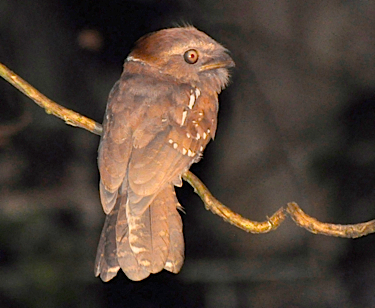
Our greatest
surprise of the trip was encountering this rarely seen
Gould's Frogmouth along the BRL entrance road on one of
our night drives. (Photo by tour participant Fred Dalbey)

The male
Whitehead's Trogon, seen here on Mt. Kinabalu, is one of
Borneo's most handsome endemics. We had leisurely views of
this one. (Photo by guide Hamit Suban)
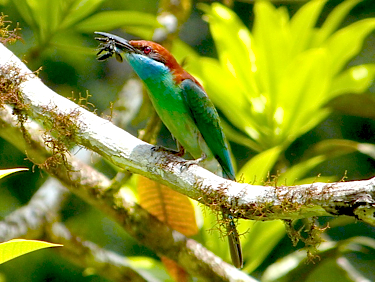
The handsome
Blue-throated Bee-eater was nesting along the Danum River
and foraging (successfully!) just outside our rooms.
(Photo by tour participant Jan Nordenberg)
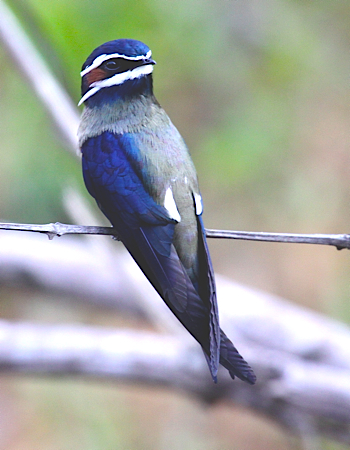
One of our
favorite companions at Borneo Rainforest Lodge, this
Whiskered Treeswift was the first of many we'd see. (Photo
by tour participant Dave Harvey)
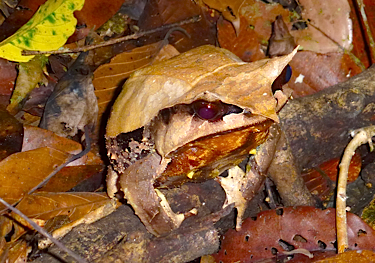
One of the most
bizarre and exciting finds of the trip was this wonderful
Bornean Horned Frog which Hamit spotted on our first night
walk at BRL. A lifer even for Rose Ann! (Photo by guide
Rose Ann Rowlett)
MAMMALS
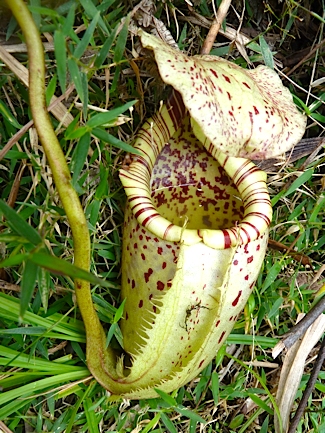
The colorful
Nepenthes burbigeae was the first of four species of
pitcher plants we saw along the Nepenthes Trail at
Mesilau. (Photo by tour participant Deby Galloway)
ADDITIONAL COMMENTS
One of the joys of birding in Borneo is all the delightful distractions that come in varied and exotic forms from other parts of the animal kingdom. Our triplist database contains only birds and mammals, but we had a long list of additional write-ins, including a few plant species of exceptional interest. To mention a very few, emphasizing those that we were able to identify:
Among the plants:
--Rafflesia keithii - We traveled to Poring to see the flower of this fascinating Bornean endemic, the largest of its genus in Borneo and the second largest in the world. An endoparasite, it has no stems, leaves, or true roots, deriving its energy entirely from its host, a woody vine in the genus Tetrastigma (Vitacease). We discussed how scientists and the Kinabalu Park staff work with locals to enhance the environmental conditions favorable to this rare and impressive flower, namely by making its host vine available for distribution on nearby private lands. It has worked well, increasing the probability of our encountering an ephemeral Rafflesia flower somewhere near Poring on our tour. This June we saw several buds and a fabulous blossom on its third day open. A recent study on Rafflesia cantleyi determined that the parasite was not only absorbing nutrients from its host, but was actually stealing genes! For details on this horizontal gene transfer, a rare phenomenon among organisms more complex than bacteria, go to: http://www.biomedcentral.com/presscenter/pressreleases/20120608
--Carnivorous Nepenthes pitcher plants - The pitcher plant center of Borneo (and the world!) is upper-elevation Mt. Kinabalu. As an alternative to climbing the Summit Trail in search of Friendly Bush-Warbler, some of us drove to Mesilau, at 2000m, where we took a steep (but short) trail to see 4 different species of pitcher plants: N. burbigeae (a colorful one!), N. fusca (a small one), N. tentaculata (the same one that was seen by the group birding the Summit Trail); and N. rajah (see my cover photo), a.k.a. Rajah Brooke's Pitcher Plant, the largest pitcher plant in the world, its pitcher holding up to 3.5 liters of liquid! Recent research has revealed the "evolutionary incentive" for high-elevation pitcher plants to have evolved bigger and bigger pitchers: It's to serve as a toilet for treeshrews! Treeshrews, which are common at these high elevations (where insects become increasingly scarce) are attracted by the sweet secretion on the underside of the pitcher's lid. To reach it, they climb onto the pitcher's sturdy rim, which fits them perfectly, and sip away, meanwhile defecating into the pitcher to mark their feeding territory--thus supplying all the nitrogen critical to these normally carnivorous plants. See the following link for a full explanation, with photos: http://news.bbc.co.uk/earth/hi/earth_news/newsid_8552000/8552157.stm
Reptiles & amphibians of particular interest were:
--the Mangrove Skinks (Emoia atrocostata) that were skittering in the mud among the mangrove roots at the KK Wetland. This species is one of the few lizards besides geckos to colonize many Pacific islands, perhaps because they tolerate saltwater.
--Apparently the most common skink we encountered--the bronzy-brown one in the leaf litter throughout the lowlands--was what is often called "common sun skink" (Eutropis multifasciatus), formerly in the genus Mabuya. It occurs throughout the region.
--that 12' Estuarine Crocodile (Crocodylus porosus) along the Kinabatangan that so blended with the mud around it that our cameras couldn't focus! The largest of all living reptiles, old males can reach an amazing 20' in length! Given its size, ours was probably a sexually mature male of 16 years or more. We also saw a small juvenile along the Menanggul.
--big Water Monitors (Varanus salvator), from the KK Wetlands to the Kinabatangan tributaries to the road into BRL
--the brilliant Green Crested Lizards (Bronchocela cristatella) that we saw several times, from our first day afield, to the Sukau boardwalk, to BRL, which can change their color to a darker gray or brown, especially when threatened
--small "flying lizards" of the genus Draco - They were seen at RDC and along the Menanggul.
--the giant Tokay Geckos (Gekko gecko) that were usually under the covered section of the boardwalk between the rooms and the dining area at Sukau Rainforest Lodge; these were the ones we heard throughout the lowlands, uttering the loud "gec-ko" or "to-kay" that slows down; it was for this species that the genus was named.
--the many (and various!) smaller geckos, from those positioned near each lamp along the BRL boardwalk to our chalets, one of which seems to have been some kind of "parachute gecko" with broad extensions on its toes and sides, to the one we found on our first night walk toward the staff quarters, which seems to have been some species of bent-toed gecko (though hard to pin down to species)
--that Mangrove (or Yellow-banded) Cat Snake (Boiga dendrophila), the shiny black snake with the bright-yellow bands that was so tightly coiled in a tree overhanging the Tenangang that we could hardly see it! Their diet consists of birds and their eggs, amphibians, lizards, other snakes, mouse deer (!), and treeshrews.
--the big, colorful Reticulated Python (Python reticulatus) that seemed frozen on the bank of the Kinabatangan one night. I guess I shouldn't really say "big," as they normally reach 10-20'!
--the Four-lined Tree Frog (Polypedates leucomystax)(a.k.a. White-lipped Tree Frog or Bush Frog) we spotlighted along the Sukau boardwalk and on a BRL night drive. Ours were fairly small ones, but the species can be over 5" long and is the world's largest treefrog. It's widespread, from s. Asia through Sundaland to Papua New Guinea and n. Australia.
--those richly yellow File-eared Tree Frogs (Polypedates otilophus) seen on our BRL night drive after the rain. They occur only in Sumatra and Borneo, ordinarily well above the ground. But they congregate over water to breed and lay their fertilized eggs into a foam mass that will harden on the outside while remaining liquid on the inside, providing the tadpoles a suitable environment until the mass falls into the water below.
--the numerous Harlequin Flying Tree Frogs (Rhacophorus pardalis) seen at BRL after the rain, from both the night-drive truck and at the frog pond. This little frog spends most of its time in the canopy, only coming to the ground to breed in suitable streams and pools. It too is a foam nest builder, but it's one of the "flying" frogs, with extensive membranes between its toes to help it glide from branch to branch--and down to pools on the forest floor. It occurs in peninsular Malaysia, Sumatra, Borneo, and the Philippines. The more colorful individual with the irregular white spots on its back seems to be of this rather variable species too, perhaps a younger one?
--But that Bornean Horned Frog (Megophrys nasuta) that Hamit found on our first night walk along the BRL Nature Trail topped them all! The epitome of dead-leaf mimicry, this species preys on other inhabitants of the rainforest leaf litter: spiders, small rodents (!), lizards, and other frogs. It's not restricted to Borneo, but found throughout Sundaland.
Among the many invertebrates were some that simply must be remembered:
--the common Wood Nymph (Idea stolli) or Tree Nymph butterflies that floated tissue paper-like throughout the lowlands
--the striking black-and-yellow Common Birdwings (Trioides helena)
--the lovely black and chartreuse Rajah Brooke's Birdwings (Trogonoptera brookiana)
--the many other superb butterflies [see the following website to help ID some of your photos: http://www.learnaboutbutterflies.com/Malaysia%20thumbs.htm]
--the impressive big moths attracted to lights throughout, including the big Lyssa moth (Lyssa menoetcus), the 8" Atlas moth (Attacus atlas) at Fred & Sonia's bungalow at Kinabalu (see Fred's cover photo), and the other big Atlas we photographed at BRL. These are supposedly the same species, but the one at Kinabalu had far more snake's-head-like wingtips than the lowland one. It's a saturnid that's found in the tropics and subtropics of SE Asia and across the Malay archipelago. In Hong Kong the Cantonese name for it translates to "snake's head moth." It's considered the largest moth in the world based on total wing surface area.
--the fancy white Lantern Bug (Pyrops sultana, family Fulgoridae), with the deep red-and-orange snout-like head, that Ron & Deby photographed at BRL. Contrary to the belief of Linneaus, who described several species, this inflated head process does not light up at night. These are sap suckers, which excrete excess sugars as droplets that certain ants have become specialized to collect!
--Which reminds me of the gigantic ants on the forest floor; and the long stream of termites (not ants!) that we watched going up the big walkway-supporting canopy emergent in the morning (and down in the afternoon).
--that wonderful black-and-orange Trilobite Beetle (Duliticola paradoxa; at Kinabalu) that retains its larval form even when sexually mature; that black-and-orange longhorn beetle (Cerambycidae; along Bukit Ular trail), and all the big black rhinoceros beetles, some with impressive horns; I haven't ID'd the many we photographed.
--that gigantic katydid we found dead at BRL, as well as the various living katydids of multiple species; all the big cicadas, walking sticks, praying mantids, and other amazing insects in the lowland rainforest
--the hordes of cockroaches and scutigerid centipedes that decorated the walls of Gomantong Cave (and the one on the tree buttress at BRL!)
--those long, dark millipedes with bright orange legs; and short, fat Pill Millipedes (Glomeris connexa) that curl into a ball like a pillbug, both fairly common at BRL
--some wonderful spiders, including some big orb weavers, lots of "wolf spiders" with eyeshine, and that big arboreal tarantula (Theraphosidae) that Paul pointed out on our final night drive at BRL
--And did I mention the leeches at BRL? They weren't especially bad this year, and I saw only the more common Brown Leeches (Haemadipsa zeylanica) and none of the endemic Tiger Leeches (haemadipsa picta). Still, they informed our fashion and left several of us with a "battle scar" (and an official leech certificate!) to show off at home.
Like Kinabalu itself, that's just the "tip of the batholith." There are LOTS of fabulous critters out there, and we encountered only a small (but wonderful!) sampling of them.
Totals for the tour: 281 bird taxa and 27 mammal taxa
